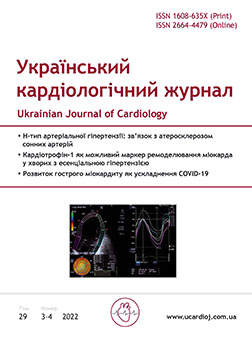Prevalence of risk factors, characteristic of the fatty acid spectrum of blood plasma and the state of providing medical care to patients with coronary heart disease – residents of various high-altitude zones of Transcarpathia
Main Article Content
Abstract
The aim – to identify risk factors and features of the clinical course of various forms of coronary heart disease in residents of the mountains and plains of the Carpathian region and to assess the effectiveness and scope of medical care for these patients.
Materials and methods. 296 people were involved in the study, of which 105 were residents of mountain region and 191 were residents of plains. In patients who suffered myocardial infarction with and without elevation of the ST segment, the state of medical care was also evaluated. When examining patients, general clinical methods were used, anthropometric data were evaluated, total cardiovascular risk and cardiovascular risk were determined according to the SCORE scale, office blood pressure was measured, ECG was recorded, and lipid metabolism indicators were studied. In some patients with stable CAD, parameters of the fatty acid composition of blood plasma were assessed using the gas chromatography method.
Results and discussion. The study compared two groups of patients: group 1 – patients with coronary artery disease living in mountainous areas (n=54); group 2 – patients with coronary artery disease living in a flat area (n=62). When comparing the fatty acid composition of blood plasma, significant differences were found between residents of plain and mountain region. Mountain dwellers compared to plain dwellers had statistically significantly higher levels of saturated myristic and stearic fatty acids, palmitoleic monounsaturated fatty acid, and two ω6-polyunsaturated fatty acids (γ-linolenic and digomo-gamma-linolenic fatty acids); these differences were found in the general comparison group and separately in the subgroups of men, people over 40 years old, in people with excess body weight or obesity (according to the body mass index), in people with abdominal obesity (according to the waist circumference indicator), who had at least one comorbid disease (hypertension, stable ischemic heart disease or type 2 diabetes). In mountain residents with excess body weight or obesity, the presence of type 2 diabetes or hypertension was also associated with lower levels of ω3-docosahexaenoic fatty acid.
Conclusions. Higher levels of myristic fatty acid, ω6-andrenic fatty acid and lower levels of ω3-docosahexaenoic fatty acid in obese mountain people are likely predictors of the occurrence and progression of comorbid pathologies. When performing primary percutaneous coronary intervention, the mortality of patients with acute coronary syndrome does not depend on the region of residence (mountain, plain population). The further the catheterization center is located, the fewer patients undergo urgent primary percutaneous coronary intervention, which is associated with late diagnosis of acute coronary syndrome and, accordingly, with untimely transportation of the population to the catheterization laboratory. In order for patient transportation to take the least amount of time, catheterization centers should be located as close as possible. Residents of the mountain zone who have limited access to medical care, compared to residents of flat settlements (condition of roads, communication links, distance from district centers), need regular medical examinations to reduce the risk of occurrence and improve the prognosis of patients with cardiovascular diseases.
Article Details
Keywords:
References
Державна служба статистики України: офіційний сайт: [Електронний ресурс]. URL: http://www.ukrstat.gov.ua.
Європейська база даних статистичної інформації «Здоров’я для всіх» [Електронний ресурс].
Про статус гірських населених пунктів в Україні. Верховна Рада України [Електронний ресурс]. URL: https://zakon.rada.gov.ua/laws/show/56/95-вр#Text.
Кедик А.В., Рішко М.В., Куцин О.О. Вплив висоти проживання на стан жирнокислотного спектру плазми крові у мешканців закарпатської області з надмірною вагою та ожирінням. Всеукраїнська науково-практична конференція. Актуальні питання сучасної медицини і фармації (до 50-річчя заснування ЗДМУ); 2018, трав 17-18; Запоріжжя. Запоріжжя, 2018. С. 60–61.
Кедик А.В., Рішко М.В. Гендерні та вікові особливості жирнокислотного спектру плазми крові у мешканців гірських населених пунктів закарпатської області. ScienceRise: Medical Science. 2018;6(26):16-9.
Рішко М.В., Устич О.В., Куцин О.О., Кедик А.В. Ефективність організації медичної допомоги та особливості перебігу гострого інфаркта міокарда у пацієнтів з інтактними та малозміненими вінцевими артеріями, які проживають у гірській місцевості Українських карпат. Укр. кардіол. журн. 2016. № 3 (Дод):146.
Тащук В.К., Хребтій Г.І., Савчук О.В. Маса тіла у хворих з серцево-судинною дисфункцією при артеріальній гіпертензії. Клінічна та експериментальна патологія. 2017. №16(2). С. 72–75.
Catapano AL, Graham I, De Backer G, Wiklund O, Chapman MJ, Drexel H, et al. ESC/EAS Guidelines for the Management of Dyslipidaemias: The Task Force for the Management of Dyslipida emias of the European Society of Cardiology (ESC) and European Atherosclerosis Society (EAS)Developed with the special contribution of the European Assocciation for Cardiovascular Prevention & Rehabilitation (EACPR). Eur Heart J. 2016;48-54. DOI: https://doi.org/10.1093/eurheartj/ehw272.
Hofstetter L, Scherrer U, Rimoldi SF. Going to high altitude with heart disease. Cardiovascular Med. 2017;20(4):87-95. DOI: https://doi.org/10.4414/cvm.2017.00478.
Kedyk AV, Rishko MV. Indexes of fatty acid metabolism as a predictors of high risk of myocardial infarction for the transcarpathian region residents with overweight. ІІ міжнародна науково-практична конференція «Терапевтичні читання: сучасні аспекти діагностики та лікування захворювань внутрішніх органів» (присвячена пам’яті академіка НАМН України Є.М. Нейка); 2016, жовт 6; Івано-Франківськ. Івано-Франківськ; 2016. С. 307.
Kedyk AV, Kutsyn OO, Rishko MV. Screening for dyslipidemia and assess the expedience of statin therapy in dwellers of valley regions of transcarpathia withoverweight and obesity. Int J Med and Med Res J. 2017;3(1):11-4.
Levine BD. Going High with Heart Disease: The Effect of High Altitude Exposure in Older Individuals and Patients with Coronary Artery Disease. 2015;16(2):89-96. https://doi.org/10.1089/ham.2015.0043.
Parati G, Agostoni P, Basnyat B. High Altitude Exposure Among People With Cardiovascular Conditions. Eur. Heart J. 2018;39(17):1546-54. DOI: https://doi.org/10.1093/eurheartj/ehx720.
Verratti V, Falone S, Doria C, Pietrangelo T, Di Giulio C. Kilimanjaro Abruzzo expedition: effects of high-altitude trekking on anthropometric, cardiovascular and blood biochemical parameters. Sport sciences for health. 2015;11(3):271-8. https://doi.org/10.1007/s11332-015-0235-z.

